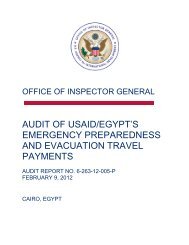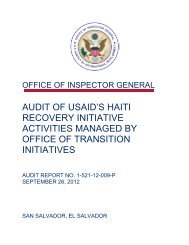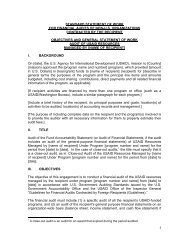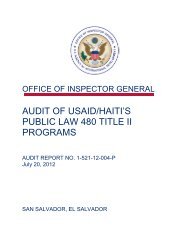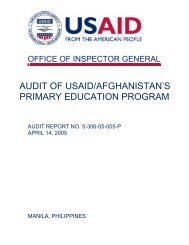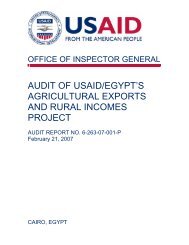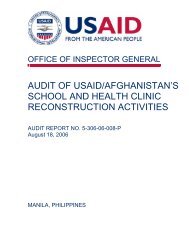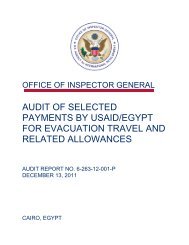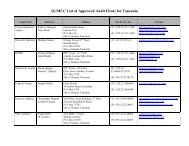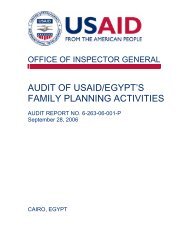USAID OIG Afghanistan and Pakistan Oversight Report, April-June ...
USAID OIG Afghanistan and Pakistan Oversight Report, April-June ...
USAID OIG Afghanistan and Pakistan Oversight Report, April-June ...
- No tags were found...
You also want an ePaper? Increase the reach of your titles
YUMPU automatically turns print PDFs into web optimized ePapers that Google loves.
Assistance under the program was generally provided in the form of goods <strong>and</strong> services to those who havesuffered losses—a farmer might receive a tractor or livestock <strong>and</strong> a grocer might receive merch<strong>and</strong>ise torestock his store. At the midpoint of the program, just over 800 of the more than 6,000 eligible families inthe program were receiving assistance, about 13 percent. As of January 22, 2009, the implementer reportedthat it had assisted only about 40 percent of families included in its revised recovery plan, which had beensubmitted just after the implementation midpoint.In addition, until the program was halfway through, <strong>USAID</strong> officials had very limited involvement in theprogram <strong>and</strong> little information about its progress. Officials had not followed up regularly on the status ofthe implementer’s implementation plan, monitoring <strong>and</strong> evaluation plan, or quarterly program reports. Themission also had not made sufficient site visits to evaluate the program’s progress <strong>and</strong> had not properlymonitored the staffing of positions for the implementing organization.Security concerns contributed to the program’s understaffing, which continued to be a challenge at the timeof the audit. As of January 2009, a subcontractor for the implementer had hired only 56 of the 86 employeesthat it believed necessary to meet program targets. At the time of the audit, the implementer’s documentsindicated that its subcontractor was still in the process of hiring 30 staff members for the six regional officeswhere the program was being implemented. In addition, the implementer had not taken advantage ofopportunities to improve the effectiveness <strong>and</strong> efficiency of the program, such as limiting the program’seligibility period <strong>and</strong> requiring beneficiaries to present Afghan national identification cards.Audit of <strong>USAID</strong>/<strong>Afghanistan</strong>’s Power Sector Activities Under Its <strong>Afghanistan</strong> InfrastructureRehabilitation Program (<strong>Report</strong> No. 5-306-10-002-P, November 10, 2009)Providing electrical power to the Afghan population is crucial to <strong>Afghanistan</strong>’s development. As a key topolitical stability, sufficient, reliable electrical power is especially important for both the capital city of Kabul<strong>and</strong> the southern agricultural provinces of Helm<strong>and</strong> <strong>and</strong> K<strong>and</strong>ahar. To improve the availability of electricityin these areas, <strong>USAID</strong>/<strong>Afghanistan</strong> awarded two major task orders under its <strong>Afghanistan</strong> InfrastructureRehabilitation Program to the Louis Berger Inc./Black <strong>and</strong> Veatch Special Projects Corp. Joint Venture.<strong>OIG</strong>’s audit report highlighted problems faced by two power projects in <strong>Afghanistan</strong>—building a 105-megawatt plant in Kabul <strong>and</strong> making improvements in the Kajakai Dam—which were intended to supplypower to key cities <strong>and</strong> provinces.The audit concluded that, because of construction delays, <strong>USAID</strong> had not increased reliable power suppliesto these two areas within the planned timeframes. For the Kabul Power Plant, the delays were caused by aninitial inability to obtain adequate title to l<strong>and</strong> for the power plant, an ambiguous statement of workresulting in poor planning <strong>and</strong> implementation, subcontractor performance problems, a lack of onsitequality assurance, <strong>and</strong> problems clearing equipment <strong>and</strong> material through customs. For the Kajakai Damproject, deteriorating security in southern <strong>Afghanistan</strong> <strong>and</strong> inconsistent contractor performance contributedto the delay.By May 2009, the <strong>USAID</strong>-funded projects had completed construction of generators with the ability toproduce only 12 megawatts of power out of the original goal of 140 megawatts—<strong>and</strong> this increase in powerhad not actually been delivered to the Afghan population. As a result, the economic benefits anticipated forKabul <strong>and</strong> the southern provinces of Helm<strong>and</strong> <strong>and</strong> K<strong>and</strong>ahar were not being realized. Additionally, the<strong>USAID</strong> <strong>OIG</strong> <strong>Afghanistan</strong> <strong>and</strong> <strong>Pakistan</strong> <strong>Oversight</strong> <strong>Report</strong> 85



